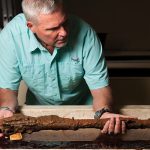By Isabel Zermani
I moonlight as an archaeologist. In Egypt. If I wrote a comic book hero for myself, I’d probably have her say something like that, but it also happens to be true.
I fell into it. Fate conspired: a chance glimpse of a flier on my UNCW professor’s door. If only I’d been walking down the hall a little faster or dropped my books, I’d have missed out. At least, in Victorian literature, that’s what happens. And Victorian literature is inextricably woven into the field. Tents, pith helmets, Howard Carter on the brink of madness before discovering Tutankhamen’s tomb in the Valley of the Kings; these all swirl in the collective memory. It seems far away — but it isn’t.
I have a host of friends around the world who are archaeologists, Egyptologists, getting their Ph.D.s in ancient Mediterranean economics or the forensic science of coins; friends who research the diets of the workers who built the Great Pyramids at Giza. I can hear some of you screaming, How will you get a job? and — believe me —so do they, but they risk in the Victorian exploration tradition. And sometimes, they get the best jobs.
I am the outlier. I am the artist. My degree is in art history, but my archaeology training is on-the-job. I’ve excavated four summer seasons at Tell Timai, in the dark brown dirt (10 YR 3/3 for those with a Munsell color chart). This site is on farmland in the Egyptian delta, not the desert. Some days, in the hallucinogenic heat, the dirt looks like chocolate.
From dawn to lunch I dig, but for the rest of the day, I draw. My bread-and-butter is ceramics. The plastic of the ancient world, there is tons to be recorded for the ceramicist (the professor with the flier). Why don’t you just take a picture? I hear your cries. We most certainly do, but until cameras have calipers that can record millimeters of data, technical drawing persists. I relish illustrating the figurines. For me, to draw something is to know it. Perhaps how the Victorian mindset has gripped me is the reverence I feel. A forgettable token, a home-altar deity or game board, when buried for 2,000 years and excavated, radiates a special connection with all human life. What seemed remote is tangible, in hand.
This sets off a butterfly effect that — if this were a comic book — would ripple back through the space-time continuum to that person. The hair on Howard Carter’s neck would stand up; Flinders Petrie would sit up in bed; Amelia Edwards, co-founder of the Egyptian Exploration Society (EES), would hear her name.
I, sensitive-artist-prone-to-wild-ideas, feel that synchronicity. Maybe I was dehydrated. But maybe there is no chronology in the space-time continuum; maybe it’s one big web. Or a small world.
Teams of Egyptian workers from a village called Quft were trained by and excavated with Petrie and Carter. They are called “Quftis” and their descendants work on the same excavation I do. Let that sink in.
Flash forward six years, four excavation seasons. My peers are deep into their theses or fellowships. I’ve stayed on the creative arts track — after all, I’m just moonlighting.
At the end of the last dig season, I flew to London. Nervously, I arranged a meeting with the director of the EES to present my side project: an illustrated outreach book, The Story of Ancient Timai, created for the village schools near the site.* Eighty-eight pages of history, the final 10 are a comic book. Awareness is a step to protect threatened sites, and Timai’s story is the village’s birthright. Proud of what I’d done, I still felt silly, unqualified, just an artist, but I kept the appointment.
Unprompted, the director reminds me that EES co-founder Amelia Edwards was both an artist and writer. Her illustrated Egyptian travelog ignited vigor to save threatened monuments and discover the still-sealed mysteries. Isn’t it all dug up by now? you ask. Not even close. Edwards’ organization would help fund missions by both Petrie and Carter — who also got his start as an artist on digs.
The space-time continuum snaps at that moment.
Victorian fate asserts its serendipity.
In a comic book, this is where you lose gravity and levitate, overwhelmed and uplifted by the adventure of what you don’t yet know.
*A National Geographic Society grant funded production, publishing, and distribution of 2,000 free copies of the bilingual book to the village schools surrounding Tell Timai. www.telltimai.org
Isabel Zermani, our senior editor, prefers the storied life.


